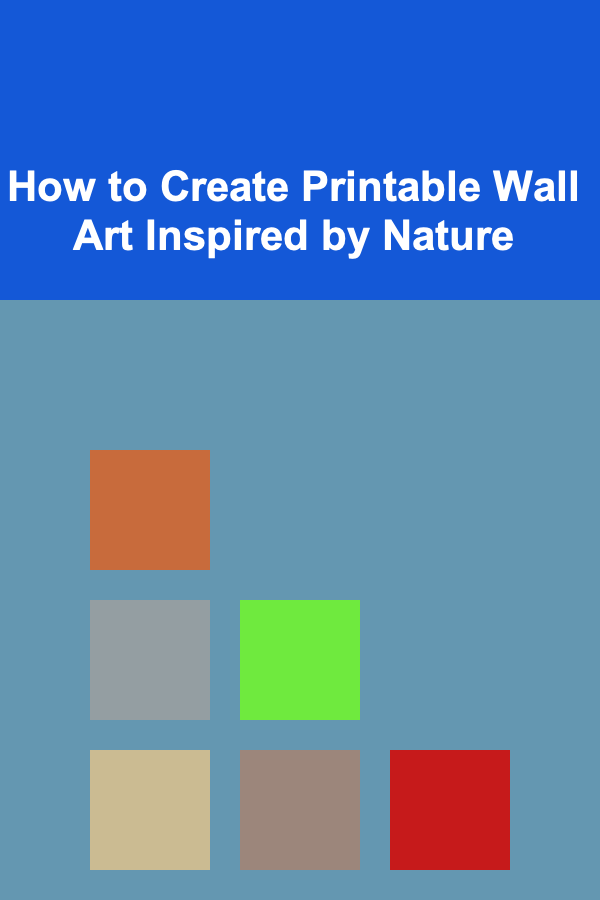
How to Create Printable Wall Art Inspired by Nature
ebook include PDF & Audio bundle (Micro Guide)
$12.99$10.99
Limited Time Offer! Order within the next:

Creating printable wall art inspired by nature is an excellent way to bring the beauty of the outdoors into your home or office. Nature has always been a timeless muse for artists, designers, and creatives, providing a rich variety of textures, colors, and forms that can be interpreted in countless ways. Whether you are an experienced artist or a beginner with an eye for design, making printable wall art inspired by nature is both a rewarding and accessible process.
In this article, we will explore the steps, tools, and techniques you can use to create stunning, nature-inspired wall art that is not only visually appealing but also highly personal. From conceptualization to final print, we'll cover every step in the process of creating art that captures the essence of nature in a way that's uniquely yours.
Understanding the Concept of Nature-Inspired Art
Before diving into the technical steps of creating wall art, it's essential to understand what "nature-inspired art" is and how you can interpret nature in an artistic form. Nature-inspired art refers to any artwork that draws its influence from the natural world, including landscapes, flora, fauna, and natural patterns. Nature has an incredible diversity, from serene forests and beaches to dramatic mountains and deserts, providing endless inspiration for art.
When you create nature-inspired wall art, the goal is to capture the essence of nature in a way that resonates with the viewer. You can take a literal approach, like portraying realistic depictions of animals and plants, or you can opt for a more abstract representation using colors, shapes, and textures drawn from the environment.
Choosing Your Nature Elements
The first step in creating printable wall art inspired by nature is deciding on the specific elements of nature that will inspire your artwork. Nature is vast, so narrowing down your focus will help define the theme of your piece and ensure your artwork has a clear message or aesthetic. Here are some nature elements you might consider:
- Landscapes: Mountains, beaches, forests, deserts, and valleys are classic natural landscapes that can evoke emotions of tranquility, awe, or adventure.
- Flora: Plants, flowers, trees, and forests offer a wealth of intricate details and colors. Whether you focus on a single branch or an entire garden, flora provides ample opportunities for exploration.
- Fauna: Animals of all kinds, from birds to mammals to insects, are also popular subjects for nature-inspired art. Animals often represent certain traits or symbolism, making them an interesting choice for more conceptual pieces.
- Water: The beauty of oceans, lakes, rivers, and waterfalls is both calming and dynamic. Water in nature offers a multitude of textures, colors, and forms to experiment with.
- Natural Patterns: Nature is full of patterns, from the veins of a leaf to the ripples in the sand. Exploring these patterns can be a great way to create abstract nature-inspired art.
Choose elements that resonate with you and the space where the artwork will be displayed. Whether you're aiming for a serene and minimalistic look or a vibrant, dynamic piece, the nature elements you choose will set the tone for your work.
Gathering Inspiration and Reference Materials
Once you've chosen your nature elements, it's time to gather reference materials to guide your artistic process. These references can come from a variety of sources, such as:
- Photographs: Capture or find high-quality photographs of the natural scenes, plants, animals, or landscapes that inspire you. Consider using your own photos if you're able to get outdoors and capture the beauty firsthand.
- Nature Walks: Spend time in natural environments to observe colors, textures, and forms up close. A walk through the woods, a hike in the mountains, or a day at the beach can provide you with all the inspiration you need.
- Art Books: Browse books and catalogs of art that feature nature-inspired works. Looking at how other artists have interpreted nature can give you valuable insights and spark new ideas for your own work.
- Online Resources: Websites like Pinterest, Instagram, and even nature-focused blogs can provide a wealth of visual inspiration. Search for nature art and photography to find compositions, colors, and subjects that you can incorporate into your own designs.
The more reference material you have, the more freedom you'll have in translating nature into your art. Keep in mind that you're not aiming to copy what you see directly, but rather to interpret the natural world through your creative lens.
Deciding on Your Art Style
Next, you need to decide on the artistic style you want to use. Nature can be represented in various ways, from hyper-realistic paintings to bold, abstract compositions. Your chosen style will determine how you approach the rest of the creative process. Below are a few popular styles for nature-inspired wall art:
- Realism: Realistic art seeks to replicate nature with as much detail and accuracy as possible. If you choose this approach, you'll need to focus on creating lifelike textures, lighting, and proportions.
- Impressionism: In contrast to realism, impressionist art aims to capture the fleeting qualities of nature, such as the way light interacts with the environment. Brush strokes are often visible, and colors are used to convey mood and atmosphere.
- Abstract: Abstract art uses colors, shapes, and patterns to evoke the essence of nature rather than representing it literally. This approach allows for greater freedom and creativity.
- Minimalism: Minimalist art focuses on simplicity, often using clean lines, sparse elements, and muted colors to convey a serene or meditative interpretation of nature.
- Botanical Illustration: This detailed and scientific approach focuses on representing plants, flowers, and foliage with intricate linework and watercolor or digital coloring.
You can experiment with any of these styles, or even blend several together to create something entirely unique. The key is to choose a style that aligns with the message or atmosphere you wish to convey.
Using Color and Texture to Represent Nature
Color and texture play a crucial role in translating nature into art. The colors of nature are rich and diverse, ranging from the vibrant greens of leaves to the warm tones of sunsets. When choosing colors for your piece, consider the emotions and atmosphere you want to evoke:
- Green: Represents growth, life, and tranquility.
- Blue: Conveys calm, serenity, and vastness, often associated with water and the sky.
- Brown and Earth Tones: Evoke warmth, grounding, and connection to the earth.
- Yellow and Orange: Suggest energy, warmth, and the brightness of the sun.
- White and Light Blues: Often used to represent purity, snow, or mist.
- Bold Reds and Purples: These colors can add drama and intensity to a natural scene, such as a fiery sunset or vibrant flowers.
Textures also play a significant role in bringing your art to life. Whether you are working with digital tools or traditional mediums, you can simulate the textures of nature through:
- Brushstrokes: If you're painting, different brush techniques can create textured effects, such as the softness of clouds or the roughness of tree bark.
- Layering: Adding layers of color can create depth and texture, allowing you to replicate natural surfaces like foliage, rocks, and water.
- Patterns: The patterns found in nature---like the veins of leaves or the swirls of ocean waves---can also be integrated into your design to give it a tactile feel.
Using color and texture intentionally will help you create artwork that feels connected to the natural world.
Creating Your Artwork
Once you have your inspiration, references, style, and colors in mind, it's time to begin creating the artwork itself. Whether you are working digitally or with traditional mediums, the process is similar in that it requires patience and experimentation. Here's how to approach the creation of your nature-inspired art:
Traditional Mediums
If you're working with traditional art materials like watercolor, acrylics, oils, or pencil, the process may involve the following:
- Sketch the Composition: Start by lightly sketching the basic outlines of your composition. Use your references to position elements such as trees, flowers, animals, or landscapes.
- Block in Colors: Once you're happy with the layout, begin blocking in colors. Don't worry about details at first; focus on filling in large areas with base colors.
- Build Layers: Add layers of color to refine the shapes and add depth to your work. Gradually work on finer details such as textures, shadows, and highlights.
- Add Details: Use smaller brushes or fine pens to add intricate details such as leaves, feathers, or animal features. Pay attention to the textures and patterns you want to highlight.
- Final Touches: Once the artwork is nearly finished, step back and evaluate the piece. Make any final adjustments to balance colors, sharpen edges, and add highlights or shadows to give your artwork more depth.
Digital Art
If you're using digital tools such as Photoshop, Illustrator, or Procreate, the steps are similar, though with the advantage of being able to work in layers and use digital brushes that mimic traditional textures. Here's how to approach it:
- Create a New Document: Set up your canvas size based on the intended print dimensions for your wall art (e.g., 24" x 36" for a large print).
- Sketch the Design: Use a basic digital pencil or sketch brush to outline your design on a new layer.
- Add Base Colors: Create separate layers for different elements of the composition, such as the sky, ground, and any plants or animals. Use a fill tool or paintbrush to apply base colors.
- Layering and Detailing: Use different brushes for textures (like watercolors or oil paints) to add depth and detail to the artwork. You can use digital tools to simulate the effects of traditional media, such as blending, layering, and adding patterns.
- Refinement: Zoom in to refine the smaller details of the piece, adjusting contrast, brightness, and saturation to get the desired effect.
- Final Adjustments: Once your design is complete, make any last-minute tweaks to the colors, shapes, and details, and prepare the file for printing.
Preparing Your Artwork for Printing
Once your artwork is finished, it's time to prepare it for printing. To ensure that your printed wall art looks as good as it does on screen or on paper, follow these important steps:
- Set the Resolution: Ensure your file is at a high enough resolution (300 dpi is standard for high-quality prints) to maintain detail when enlarged.
- Choose the Right File Format: Save your file in a format that's suitable for printing, such as TIFF, PNG, or PDF. Avoid JPEGs as they may lose quality when printed.
- Size the Artwork: Make sure your artwork is sized to fit your intended print dimensions. If necessary, resize your image while maintaining the aspect ratio to avoid distortion.
- Color Profile: Check that the color profile is set to CMYK, which is the standard for printing. This ensures that the colors in your artwork are accurately represented when printed.
Printing and Displaying Your Wall Art
Finally, it's time to print and display your nature-inspired artwork. You can either print it at home if you have a high-quality printer, or you can use a professional printing service. Options include:
- Canvas Prints: Canvas prints give your artwork a textured, gallery-quality feel. They are especially suitable for large nature-inspired pieces.
- Framed Prints: A framed print adds elegance and protects your art from wear and tear. Choose a frame that complements the colors and style of the artwork.
- Poster Prints: For a more affordable option, poster prints are great for large, bold designs.
Once printed, display your artwork in a space where it can be admired and appreciated. Whether it's above your couch, in a hallway, or as the centerpiece of a room, your nature-inspired wall art will be a conversation starter.
Conclusion
Creating printable wall art inspired by nature allows you to merge your artistic skills with the endless beauty of the natural world. By carefully choosing your subject matter, style, colors, and techniques, you can craft a piece that reflects your unique interpretation of nature. The process may take time and experimentation, but the result will be a stunning piece of art that connects your space to the outdoors in a meaningful way. Whether you choose to work traditionally or digitally, remember that nature is a boundless source of inspiration, and with the right tools and mindset, you can create wall art that is both beautiful and timeless.
Reading More From Our Other Websites
- [Personal Investment 101] The Power of Deep Learning: How to Make Money from AI Projects
- [Home Cleaning 101] How to Keep Your Home Clean While Remodeling or Renovating
- [Tiny Home Living Tip 101] Best Flooring Options That Balance Comfort and Space Efficiency in Tiny Homes
- [Personal Care Tips 101] How to Use Hair Gel for a Soft Hold with Natural Movement
- [Home Staging 101] How to Stage a Home to Appeal to Boomer Buyers
- [Screen Printing Tip 101] Best Tips for Multi‑Color Registration Using Digital Alignment Tools
- [Organization Tip 101] How to Utilize Vertical Space for Storing Pet Items
- [Beachcombing Tip 101] Creating a Show-Stopping Shell Display: Cleaning, Mounting, and Arranging Your Finds
- [Gardening 101] Mulching for Water Conservation: Tips for Drought‑Resistant Gardens
- [Biking 101] Top 5 Bike Maintenance Mistakes and How to Avoid Them

How to Evaluate Your Jewelry Buying Habits for Better Organization
Read More
How to Organize Time for Reflection and Self-Care
Read More
How to Profit from Deep Learning by Selling Courses or Tutorials
Read More
Quality Assurance Tester's Handbook: Tools, Techniques, and Best Practices
Read More
How to Understand the Legacy of the Roman Roads
Read More10 Tips for Families to Use a Monthly Budget Tracker Effectively
Read MoreOther Products

How to Evaluate Your Jewelry Buying Habits for Better Organization
Read More
How to Organize Time for Reflection and Self-Care
Read More
How to Profit from Deep Learning by Selling Courses or Tutorials
Read More
Quality Assurance Tester's Handbook: Tools, Techniques, and Best Practices
Read More